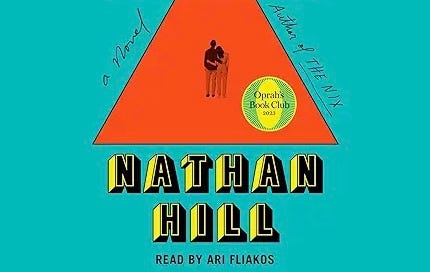BookLife Review by Carol O'Day: Wellness (Nathan Hill, author)
marriage, young life, mid-marriage crisis, childhood trauma, parental abuse and neglect, photography, placebo effect, polyamorous club
This book is not what the title may make you think. It is not about healthy living, per se, unless by that we mean healthy thinking. It is not about fitness or steps or reduced carbs or keto or getting enough sleep or taking up meditation. It is 597 pages. It is a probing examination of love, marriage, growth, change and the deep rootedness of the way we are taught, or not taught, as children to love and relate to others by our families of origin, specifically our parents. What happens to an otherwise bright and talented person when one of her parents is irretrievably broken and wounded? Wellness goes deep down this rabbit hole and examines it from some fascinating angles.
We meet Jack and Elizabeth as lonely first year college students each living in a part of Chicago that is underdeveloped and a bit rough. Jack has escaped a harsh and loveless home on the midwestern prairie. Elizabeth is the only child of affluent but morally bankrupt parents-a father who competes with his own daughter and constantly identifies her shortcomings for sport, and an absent materialistic mother. Both Jack and Elizabeth arrive in Chicago lonely and each glimpses the other through respective apartment windows that face one another across a tiny alley. The reader roots for the two to meet and connect and rejoices when they do and fall rapidly in love.
No sooner have we witness the young Romeo and Juliet meet, than the author thrusts the reader into the couple’s shared midlife crisis and disaffection. The all-consuming and glittering connection they had when they were young and fell in love seems dead and gone. Their life seems bleak. And that is essentially at chapter 2 of a 597 page book. I braced, and wondered if I could bear the remaining 500 pages. Jack spirals into a self-improvement “wearable” scheme and Elizabeth falls disturbingly far into a neurotic vortex of research on how to raise their troubled son, Toby. She researches everything about parenting and is paralyzed and unable to move forward until she has located and vetted a scholarly study that provides evidentiary proof of the best practices on any given issue-sleep, picky eating, discipline, education. The couple even ventures into a polyamorous club to explore spicing up their relationship in novel ways.
Ever so slowly (arguably painfully slowly), Hill peels back the layers. We learn more about Jack’s photography career, it’s origin in his beloved and significant older sister Evelyn’s talent as a painter, his clever adaptation to the collision of his lack of funds to support a photography career and the world of avant-garde art, and his struggles to cobble together a career as a teacher and photographer. We learn about Evelyn’s family history of opportunist ancestors, her multidisciplinary studies in psychology, ethnology and economics, her work with a professor studying decision making and placebos and her childhood on the move where she adapted to a life of impermanence and change, perpetually as the “new kid” as her father moved from one merger and acquisition to the next. We walk with the couple as they experience the universally recognized and painful stage of married life when friends exit the city for the suburbs and become buried in the world of child-rearing, constricting the couple’s social circle and making their own life more insular by default.
The book becomes more compelling as the backstory expands. Hill initially attaches us to the couple as they fall in love, but turns us against them as they seem to fall out of love and turn away from each other in the hard middle part of their married years. The reader wonders how they can possibly mend. This sets up the slow dawning of understanding that comes to the reader just a tick ahead of when is first understood by the protagonists. Hill withholds the last details that explain the intensity of Jack and Elizabeth’s childhood traumas until quite late in the novel. In the interim, he laces themes of change, psychological manipulation, and healing into the mix. He crafts scenes and B-stories replete with decisions made on unfounded information or beliefs that are only later exposed. “It is not what it seems” is represented in both the placebo effect work Elizabeth does and the chemical photo art at the center of Jack’s career. The reader begins to question the decisions each character has made about the other and whether they were based on sound information. The pace quickens as the underlying truths and hidden heartbreaks are unearthed.
Wellness is a grown up love story. It is about the many kinds of love inside a marriage–romance and lust, compassion and shared sensibility, deep platonic friendship, companionship, need, desire, individualism and togetherness. It is about the long game. It is about our willingness to grow and change alongside one another and the obstacles and pitfalls of attempting to do that. It is about understanding that we arrive at relationships with a trunk full of emotional baggage, and that how we were loved as a child is perhaps the key factor in our ability to love and be loved successfully as adults. Until we gain insight into that premise, our ability to love will be strained. Not your typical Valentine, but a worthy read nonetheless.




